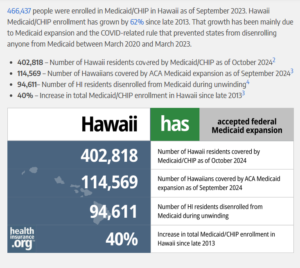Healthcare Cuts Coming; Many of Hawaii’s residents about to feel the pain
Trump Party Bill has $1.1 Trillion in Health Cuts and 11.8 Million Losing Care, per C.B.O.
Analysis from the nonpartisan Congressional Budget Office found that Republicans’ new version of President Trump’s “Big Bill” legislation now in final review in the Republican-controlled Senate would make far deeper cuts and lead to more people becoming medically-uninsured.
 President Trump’s “Big Bill” legislation now in final review in the Republican-controlled Senate would make far deeper cuts and lead to more people becoming medically-uninsured than previously proposed or imagined, with the nation’s Medicaid-dependent population feeling the weight of forthcoming government cuts to medical coverage and benefits.
President Trump’s “Big Bill” legislation now in final review in the Republican-controlled Senate would make far deeper cuts and lead to more people becoming medically-uninsured than previously proposed or imagined, with the nation’s Medicaid-dependent population feeling the weight of forthcoming government cuts to medical coverage and benefits.
As of August 2024, over 20% of Hawaii’s population was covered by Medicaid or CHIP, according to the Kaiser Family Foundation, which reported 443,802 enrollees at that time. As of February 2025, data now indicates “about a quarter of Hawaii’s population relies on Medicaid,” which would translate to roughly 28% of residents fully dependent on Medicaid for healthcare support. Within Hawaii’s total population of about 1.4 million, Medicaid expansion throughout the state reflects a strong commitment to public health coverage.
Hawaii’s Medicaid coverage rate is comparable to other Medicaid expansion states that cover adults earning up to 138% of the Federal Poverty Level. The state’s Medicaid coverage rate (about 28%) is significantly higher than the national average and most other states, ranking it among the top states for Medicaid enrollment.
The cuts in the bill are achieved through numerous provisions, but the bulk of the Medicaid savings come from two major bill features.
- It would establish a new, strict national work requirement for some people on the program, who would need to demonstrate they had worked at least 80 hours the month before they sign
 up, or qualified for an exemption. The Senate version applies this provision to the poor parents of children older than 14 in addition to childless adults without disabilities, the group targeted by the House version. The budget office estimated that that provision alone would reduce federal spending by more than $325 billion over the decade.
up, or qualified for an exemption. The Senate version applies this provision to the poor parents of children older than 14 in addition to childless adults without disabilities, the group targeted by the House version. The budget office estimated that that provision alone would reduce federal spending by more than $325 billion over the decade. - The second largest source of savings comes from new restrictions on a strategy many states use to finance Medicaid by imposing taxes on medical providers to leverage a larger federal contribution. The bill’s restrictions on provider taxes and a related mechanism known as state directed payments would cut spending by a combined $375 billion, according to the report. The House bill would freeze the tax rate for most states, but the Senate version would require many states to lower their existing taxes, beginning in 2027.
According to a report published late Saturday night, the legislation would mean:
- Over 11.8 million more Americans would become uninsured by 2034.
- Federal spending on Medicaid, Medicare and Obamacare would be reduced by more than $1.1 trillion over that period
- More than $1 trillion of those cuts coming from Medicaid alone
The fresh estimates make official what many analysts had already predicted and some Republican lawmakers had feared. The size and scope of the health care cuts in the bill, particularly from Medicaid, have been hotly debated, with fiscal hawks pressing for bigger reductions and other Republicans resisting them as they consider the impact on their constituents and health providers in their districts and states.
Republicans’ marquee domestic policy bill currently making its way the GOP-controlled Senate would result in deeper cuts and more Americans losing health insurance coverage than the original measure that passed the House last month, according to new estimates from the Congressional Budget Office. They are also at odds with President Trump’s vow not to touch Medicaid except to do away with waste and fraud.
The scale of the proposed reductions in Medicaid is unprecedented in the history of the program, which has tended to expand coverage over time since its creation in 1965.




Leave a Reply
Join the Community discussion now - your email address will not be published, remains secure and confidential. Mahalo.